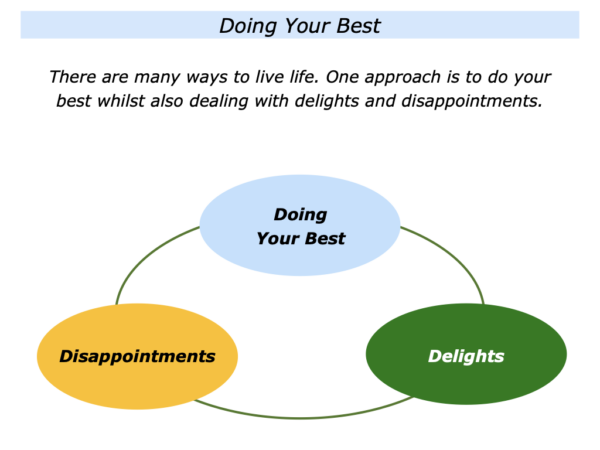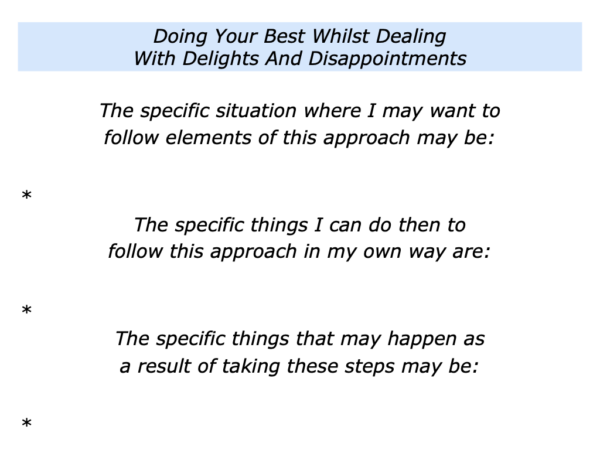
There are many ways to live life. One approach is to do your best whilst also dealing with the delights and disappointments. It is then to do your best again. Let’s explore these themes.
Doing Your Best
Different people aim to do their best in different ways. Some individuals have a framework they follow in certain situations. One person explained their approach in the following way.
“My first step is to buy time to think, see the big picture and clarify the possible options for going forwards. Bearing in mind what I can control in the situation, I then go through the following steps.
“First, to clarify the outcomes I want to achieve. Second, to clarify the strategies I can follow to give myself the greatest chance of success. Third, to then do my best to achieve the desired outcomes.
“Moving into action, I keep building on what is working and tackling areas for improvement. This often involves continuing to develop on the journey towards achieving the desired outcomes.”
Imagine that you are doing your best in a certain situation. You may be doing a creative project, tackling a challenge or working to achieve a specific goal. Sometimes there may be delights, sometimes there may be disappointments. Let’s explore these themes.
Delights
Different people see delights in different ways on the way to towards achieving their aims. Some individuals define the work they do as a delight. One person expressed this in the following way.
“For me it is a privilege to do work I love. I enjoy helping people and every day is a delight. Sometimes there are tough times. But even then I enjoy the challenge of helping people to achieve their goals.”
Some people also enjoy learning from their successes. One person described how they kept something called My Development Book. They explained this in the following way.
“Looking back on the week, I start by focusing on the successes and try to clarify the learning. Looking at each success in turn, I describe the following things.
“First, the specific things that I or other people did well and how to build on these in the future. Second, the specific things that or other people could do better in the future.”
Imagine that you are celebrating and learning from delights in your own way. Sometimes events may not always go to plan, however, which can lead to the next theme.
Disappointments
Great workers have a history of dealing with disappointments in a positive way. One mentor highlighted this when asked about the potential of a talented young person. They expressed this in the following way.
“The person you mention is talented and so far has been successful. It is difficult to assess their potential, however, until they have had a tough setback.
“This will call for them displaying resilience and development. The way they deal with such a setback will provide a good guide as to what they can achieve in their career.”
There are many ways to manage disappointments. Some people dwell on these and do not move forwards. Some people find ways to manage their feelings and begin to develop.
Different people do this in different ways. One approach is for them to become almost cerebral. Looking at the situation in a dispassionate way, they then explore the following questions.
“What actually happened in the situation? Who were the people involved and who did what? How did I or other people behave? What happened as a result of these actions?
“What were the things I could have controlled in the situation? What were the things that were beyond my control? How could I have built on what I could control and do my best to manage the other things?
“Looking ahead to potentially similar situations in the future, how can I apply the learning? Bearing in mind what I can control, how can I clarify the results to achieve? How can I then do my best to achieve these aims?
Great workers then do their best again. They have a positive attitude and embark on their next venture. They then continue to manage the delights and disappointments.
Looking ahead, can you think of a situation where you may want to follow elements of this approach? How can you do this in your own way? If you wish, try tackling the exercise on this theme.







Leave a Reply